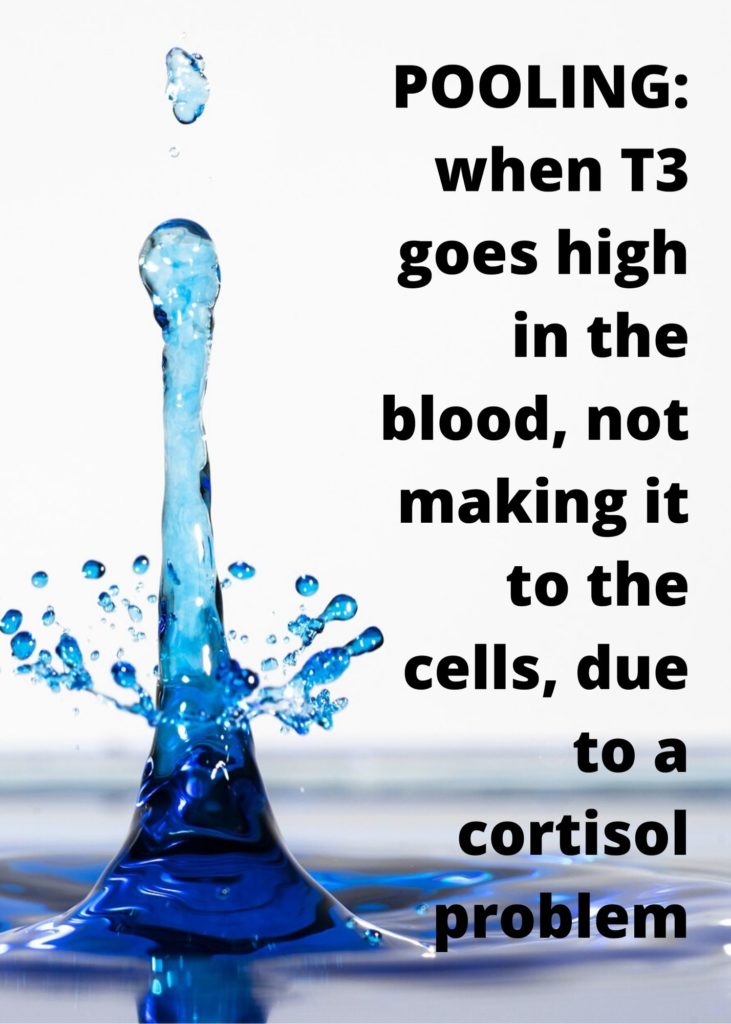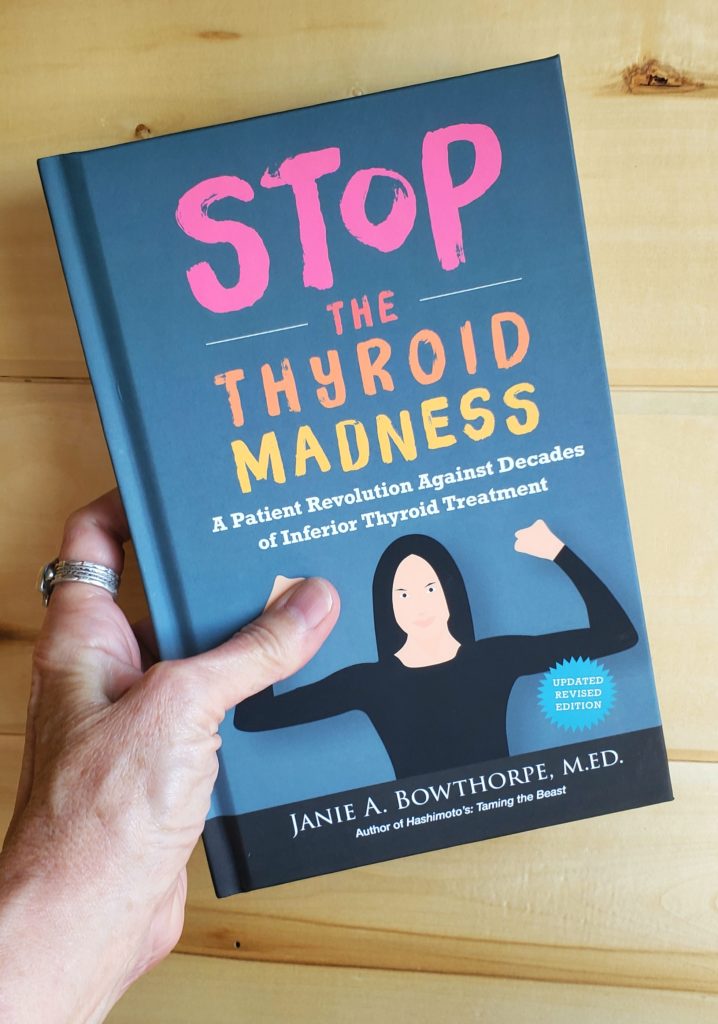
Years ago, we as hypothyroid patients due to any cause, noticed a phenomena we called pooling, due to stressed adrenals: T3 going high in the blood, and not making it to the cells. We also noticed that when trying to raise T3 in our treatment with adrenal issues, it was causing “hyper-like” symptoms like heart palps, or a higher heartrate, or anxiety, or shakiness, or any hyper-like symptoms true to you. In some, it can mean a very high FT3, and low FT4. Check out the information below. Also share the information with your doctor ~Janie, hypothyroid patient and site creator.
Pooling means your free T3 isn’t making it well to your cells, and instead, is hanging out in your blood, going higher and higher as you raise your T3-containing thyroid medication and causing hyper-like symptoms, whether you use synthetic T3, or the T3 in a working desiccated thyroid.
Why does pooling happen?
Pooling, aka your free T3 going way too high, even above range, thus not making it to the cells, is always associated with having either 1) low cortisol 2) high cortisol 3) a mix of both, and/or 4) low aldosterone, another steroid. i.e “stressed adrenals”. Even midrange aldosterone is too low.
What are symptoms patients experience due to pooling, which pushes excess adrenaline as one raises a T3-containing medication?
At first, pooling may not be recognized. But eventually, we can first note a very high free T3 or above range. As we raise, the most common symptoms are hyper-like, aka heart palpitations, a rising heartrate, palps, and in some, anxiety. Some notice increased hypothyroid symptoms, which can include fatigue, depression, etc. Others notice the “hyper-like” symptoms such as anxiety, panicky feeling, jittery, shakiness, heart palps, higher heartrate, higher blood pressure, etc. More in the STTM 1 book with the blue gray cover.
What do patients first do with signs of pooling?
There is a need to order and do a saliva cortisol test which measures what is available and unbound (unlike blood testing, which is mostly measuring what’s mostly bound and unavailable, thus not ideal at all.) And blood results do not always fit what our symptoms tell us. Plus a blood cortisol test is only at ONE TIME, and you miss what’s going on at other times. Additionally, you also need to test aldosterone, and blood works with that.
When your saliva results are sent back to you
When you get your lab results back, compare them to the information on the lab values page or the Odds and Ends chapter in the STTM 1 book with the blue gray cover. Also see the results for aldosterone. This may be information you’ll have to teach an open-minded medical professional. You will also need aldosterone tested via blood.
How to treat the results you get back
Treatment is fully explained in Chapter 6 of the STTM 1 book with the blue gray cover. So it’s important to read, study, highlight, underline and be prepared to find a doctor you can teach, because we are light years ahead of doctors.
Are there more ways I can understand my stressed adrenals?
Yes. Janie A. Bowthorpe has started two Zoom webinars to teach you all about this live! One is an Introductory Stressed Adrenals 101, and the other is Advanced Stressed Adrenals 201. Read all about each of them here: https://stopthethyroidmadness.com/webinar-coaching/
If I have no symptoms of pooling, yet it’s very clear with labs, do I not have a problem?
Patients still see a problem and need to treat the pooling, we’ve discovered, which is usually always about a cortisol issue or low aldosterone. If they are not treated, we can’t get out of our hypothyroid state!
My doctor wants me to move back over to T4-only or T4/T3, claiming the T3 in NDT is just “too much for me, thus why it’s high”.
No! Doctors don’t get “pooling” or what causes it!! So they tend to send us backwards. Read more about this in the STTM 1 book. Be informed to counter their poor training.
Are pooling and a high Reverse T3 the same thing?
No, they are two different issues. Read about rising RT3 here, and there’s more in the STTM 1 book.
In the meantime…
We learned the HARD way to never start on cortisol treatment if we pooling, as it will cause that high level of T3 to RUSH into the cells like a son-of-a-gun and give horrible hyper symptoms. We learned we have to lower that high FT3 before starting on cortisol for any low cortisol issue as discovered via the saliva test. Again, Chapter 6 in this book.
For those who go down on their T3 containing thyroid meds to lower symptoms of pooling due to a cortisol problem…patients have reported going down by half or more, allowing the pooled T3 to fall, and which can happen within a week if lowered enough. Some are able to go back up in teensy amounts as long as pooling doesn’t start again.
Bottom line:

Treatment of a cortisol problem is completely explained in chapters 5 and ESPECIALLY chapter 6 of the updated revision STTM book—–>. Teach your doctor.
This research explains the “altered interaction between T3 and cell receptors: https://pubmed.ncbi.nlm.nih.gov/3108000/
**Read more about IRON AND CORTISOL. It’s important.

Important notes: All the information on this website is copyrighted. STTM is an information-only site based on what many patients worldwide have reported in their treatment and wisdom over the years. This is not to be taken as personal medical advice, nor to replace a relationship with your doctor. By reading this information-only website, you take full responsibility for what you choose to do with the information on STTM or its outcomes. See the Disclaimer and Terms of Use.